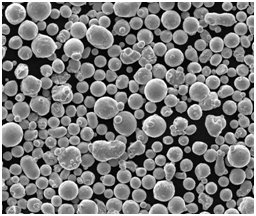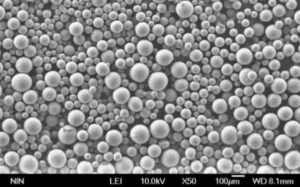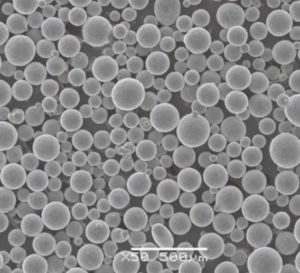A fabricação aditiva, frequentemente conhecida como impressão 3D, revolucionou as indústrias de manufatura, permitindo a criação de componentes complexos e personalizados. Entre as várias técnicas de fabricação aditiva, Fabricação de aditivos para jateamento de ligantes (BJAM) se destaca por sua versatilidade e custo-benefício. Este artigo se aprofunda no mundo do Jato de Aglutinante, fornecendo uma visão geral abrangente, examinando modelos específicos de pó de metal e discutindo as aplicações, vantagens e limitações da tecnologia. Seja você um profissional experiente ou novo no conceito, este guia o guiará pelos prós e contras do Jato de Aglutinante, garantindo que você tenha todas as informações necessárias.
Visão Geral da Fabricação Aditiva por Jato de Aglutinante
O Jato de Aglutinante é uma técnica de fabricação aditiva exclusiva que combina materiais à base de pó com um agente de ligação líquido. Ao contrário de outros métodos de impressão 3D que usam calor para fundir materiais, o Jato de Aglutinante depende desse aglutinante para criar as formas desejadas. O processo é tipicamente feito camada por camada, onde o aglutinante "cola" seletivamente as partículas de metal ou cerâmica, formando um objeto sólido.
A capacidade do Jato de Aglutinante de trabalhar com vários materiais, de metais a cerâmicas e areia, o torna uma escolha versátil. Além disso, a falta de aplicação de calor reduz o risco de distorção térmica, tornando-o ideal para geometrias complexas e estruturas delicadas.

Composição da Fabricação Aditiva por Jato de Aglutinante
O Jato de Aglutinante utiliza uma combinação de materiais em pó e um aglutinante líquido. Os materiais em pó usados no Jato de Aglutinante são cruciais para as características do produto final. Abaixo está uma análise detalhada de modelos específicos de pó de metal usados no Jato de Aglutinante.
Modelos Específicos de Pó de Metal em Jato de Aglutinante
| Modelo de pó metálico | Composição | Propriedades | Características | Formulários |
|---|---|---|---|---|
| Inconel 625 | Níquel-Cromo | Alta resistência, excelente resistência à fadiga | Resistente à corrosão, boa soldabilidade | Aeroespacial, marítimo, processamento químico |
| Aço inoxidável 316L | Ferro-Cromo-Níquel | Excelente resistência à corrosão, boa resistência | Dúctil, biocompatível | Implantes médicos, automotivo, processamento de alimentos |
| Aço inoxidável 17-4 PH | Ferro-Cromo-Níquel-Cobre | Alta resistência e dureza | Endurecido por precipitação, resistente à corrosão | Aeroespacial, nuclear, indústrias químicas |
| Cobalto-cromo | Cobalto-cromo | Alta resistência ao desgaste, biocompatível | Denso, forte | Implantes dentários, aeroespacial, dispositivos médicos |
| Cobre (Cu) | Cobre puro | Excelente condutividade elétrica, condutividade térmica | Maleável, dúctil | Componentes elétricos, trocadores de calor |
| Titânio (Ti-6Al-4V) | Titânio-Alumínio-Vanádio | Alta relação resistência/peso, resistente à corrosão | Biocompatível, forte | Aeroespacial, implantes médicos, equipamentos esportivos |
| Alumínio (AlSi10Mg) | Alumínio-Silício-Magnésio | Leve, boa resistência | Alta condutividade térmica, dúctil | Automotivo, aeroespacial, eletrônicos de consumo |
| Bronze | Cobre-Estanho | Alta resistência à corrosão, boa usinabilidade | Denso, forte | Esculturas artísticas, rolamentos, buchas |
| Aço para ferramentas (H13) | Cromo-Molibdênio | Alta dureza, resistência ao desgaste | Resistente ao calor, resistente | Ferramentas, moldes, matrizes |
| Liga de níquel 718 | Níquel-Cromo-Ferro | Excelente resistência a altas temperaturas, resistência à corrosão | Endurecível por envelhecimento, forte | Aeroespacial, geração de energia, petróleo e gás |
Características de Fabricação de aditivos para jateamento de ligantes
As características da Fabricação Aditiva por Jato de Aglutinante a tornam distinta de outras técnicas de fabricação aditiva. Aqui está uma análise das principais características:
Versatilidade de materiais
O Jato de Aglutinante funciona com uma ampla gama de materiais, incluindo metais, cerâmicas e até areia. Essa versatilidade permite várias aplicações em diferentes indústrias, da aeroespacial à odontológica.
Acabamento da superfície
Uma das características notáveis do Jato de Aglutinante é a capacidade de obter um acabamento superficial fino. A deposição camada por camada e as finas partículas de pó contribuem para superfícies lisas, reduzindo a necessidade de pós-processamento extenso.
Velocidade de produção
O Jato de Aglutinante é conhecido por sua velocidade de produção relativamente alta. Como o processo não requer energia térmica significativa, ele pode imprimir grandes lotes de peças rapidamente, tornando-o adequado tanto para prototipagem quanto para produção.
Sem Estresse Térmico
Ao contrário de outros métodos, como a Sinterização Seletiva a Laser (SLS) ou a Sinterização Direta a Laser de Metal (DMLS), o Jato de Aglutinante não envolve altas temperaturas. Isso elimina o estresse térmico, reduzindo o risco de empenamento ou distorção no produto final.
Flexibilidade de design
Com o Jato de Aglutinante, geometrias complexas e designs intrincados podem ser facilmente alcançados. Este método permite a criação de cavidades internas, estruturas de treliça e outros recursos que seriam difíceis de produzir com a fabricação tradicional.
Aplicações da Fabricação Aditiva por Jato de Aglutinante
A Fabricação Aditiva por Jato de Aglutinante encontra aplicações em várias indústrias devido à sua versatilidade e capacidade de produzir peças complexas. Abaixo está uma exploração de algumas aplicações principais:
| Aplicativo | Descrição | Setores |
|---|---|---|
| Prototipagem | Prototipagem rápida de peças com geometrias complexas para testes e validação | Automotivo, aeroespacial, bens de consumo |
| Ferramentas e moldes | Produção de ferramentas e moldes duráveis usados em vários processos de fabricação | Moldagem por injeção, fundição sob pressão |
| Dispositivos médicos | Fabricação de implantes personalizados, ferramentas cirúrgicas e dispositivos odontológicos | Médico, odontológico |
| Componentes aeroespaciais | Produção de peças leves e complexas com alta resistência e resistência à corrosão | Aeroespacial, defesa |
| Peças automotivas | Fabricação de peças personalizadas e complexas para aplicações automotivas, como componentes do motor | Automotivo |
| Itens Artísticos e Decorativos | Criação de esculturas detalhadas, joias e itens decorativos usando vários pós de metal | Arte, moda, decoração de casa |
| Trocadores de calor | Produção de designs complexos de trocadores de calor com materiais de alta condutividade térmica | HVAC, equipamentos industriais |
| Componentes elétricos | Fabricação de componentes com excelente condutividade elétrica, como conectores e barras de barramento | Eletrônica, engenharia elétrica |
| Padrões de Fundição | Produção de moldes de areia e machos para processos de fundição de metal | Fundição, fundição de metal |
| Pesquisa e desenvolvimento | Teste de materiais e design personalizados para novos produtos e inovações | P&D, instituições acadêmicas |






Especificações, Tamanhos, Graus e Padrões em Jato de Aglutinante
Compreender as especificações, tamanhos, graus e padrões associados ao Jato de Aglutinante é crucial para garantir que as peças atendam aos requisitos da indústria. Abaixo está uma tabela detalhada que descreve esses aspectos:
| Material | Classe/Padrão | Tamanhos típicos | Especificações |
|---|---|---|---|
| Inconel 625 | AMS 5666, ASTM B443 | Tamanho do pó: 15-45 µm | Densidade: 8,44 g/cm³, Ponto de fusão: 1290-1350°C |
| Aço inoxidável 316L | ASTM F138, ISO 5832-1 | Tamanho do pó: 15-53 µm | Densidade: 7,99 g/cm³, Ponto de fusão: 1371°C |
| Aço inoxidável 17-4 PH | AMS 5643, ASTM A564 | Tamanho do pó: 10-45 µm | Densidade: 7,80 g/cm³, Dureza: HRC 40-47 |
| Cobalto-cromo | ASTM F75, ISO 5832-4 | Tamanho do pó: 10-30 µm | Densidade: 8,30 g/cm³, Ponto de fusão: 1330-1390°C |
| Cobre (Cu) | ASTM B124, AMS 4501 | Tamanho do pó: 15-60 µm | Densidade: 8,96 g/cm³, Ponto de fusão: 1083°C |
| Titânio (Ti-6Al-4V) | ASTM F1472, AMS 4911 | Tamanho do pó: 15-45 µm | Densidade: 4,43 g/cm³, Ponto de fusão: 1600-1660°C |
| Alumínio (AlSi10Mg) | ISO 3522 | Tamanho do pó: 20-63 µm | Densidade: 2,68 g/cm³, Ponto de fusão: 577-660°C |
| Bronze | ASTM B584, SAE J463 | Tamanho do pó: 20-80 µm | Densidade: 8,7-8,9 g/cm³, Ponto de fusão: 950-1050°C |
| Aço para ferramentas (H13) | ASTM A681 | Tamanho do pó: 10-50 µm | Densidade: |
| Liga de níquel 718 | AMS 5662, ASTM B670 | Tamanho do pó: 15-53 µm | Densidade: 8,19 g/cm³, Ponto de Fusão: 1260-1336°C |
Detalhes de fornecedores e preços
Ao obter pós metálicos para Binder Jetting, é essencial considerar fornecedores confiáveis e preços. A tabela abaixo fornece uma visão geral dos fornecedores potenciais e preços aproximados para diferentes
pós metálicos:
| Fornecedor | Material | Preços (Aprox.) | Notas |
|---|---|---|---|
| Aditivo GKN | Inconel 625, 316L SS, Ti-6Al-4V | $100 – $300 por kg | Pós de alta qualidade, fornecedor global |
| Höganäs AB | 17-4 PH SS, Alumínio, Bronze | $150 – $400 por kg | Produtor líder de pó metálico, formulações personalizadas |
| Aditivo Carpenter | Cobalto-Cromo, Liga de Níquel 718 | $200 – $500 por kg | Materiais premium, foco aeroespacial e médico |
| Manufatura aditiva da Sandvik | Aço para Ferramentas H13, Cobre | $120 – $350 por kg | Materiais avançados, amplas capacidades de P&D |
| Tecnologia LPW | Vários pós de metal | $180 – $450 por kg | Pós de alto desempenho, padrão da indústria |
| Arcam AB (GE Additive) | Ligas de titânio, Inconel 718 | $250 – $600 por kg | Especializado em aplicações aeroespaciais e médicas |
| AP&C (uma empresa da GE Additive) | Alumínio, Aços inoxidáveis | $200 – $500 por kg | Experiência em pós esféricos de alta qualidade |
| EOS GmbH | Vários pós de metal | $220 – $550 por kg | Conhecido pela consistência e qualidade |
| Renishaw plc | Aços inoxidáveis, Titânio | $190 – $480 por kg | Engenharia de precisão e materiais avançados |
| TANIOBIS GmbH | Cobalto-Cromo, Ligas de Níquel | $210 – $550 por kg | Soluções inovadoras de materiais, com foco em P&D |
Vantagens e limitações do Fabricação de aditivos para jateamento de ligantes
Como qualquer processo de fabricação, o Binder Jetting tem seus prós e contras. Compreender isso pode ajudar a decidir se este método é o mais adequado para o seu projeto.
Vantagens
| Vantagens | Descrição |
|---|---|
| Diversidade de materiais | O Binder Jetting pode usar vários materiais, incluindo metais, cerâmicas e areia, oferecendo flexibilidade em aplicações. |
| Sem Distorção Térmica | A ausência de calor no processo significa que as peças estão livres de empenamento ou tensões residuais, levando a uma maior precisão. |
| Alta Velocidade de Produção | Adequado para produzir grandes lotes rapidamente, o Binder Jetting é eficiente tanto para prototipagem quanto para produção. |
| Excelente Acabamento Superficial | As finas partículas de pó utilizadas resultam em superfícies lisas, reduzindo a necessidade de pós-processamento. |
| Geometria complexa | Ideal para criar designs intrincados e recursos internos que são difíceis com os métodos de fabricação tradicionais. |
Limitações
| Limitação | Descrição |
|---|---|
| Porosidade do Material | As peças podem exigir infiltração ou sinterização para atingir a densidade total, o que adiciona etapas e custos adicionais. |
| Propriedades mecânicas | A resistência mecânica das peças Binder Jetted pode não corresponder àquelas produzidas por outros métodos, como DMLS ou fundição. |
| Requisitos de pós-processamento | Embora o acabamento superficial seja bom, algumas aplicações ainda podem exigir pós-processamento adicional, como usinagem ou infiltração. |
| Seleção limitada de materiais | Embora versátil, nem todos os materiais são adequados para Binder Jetting, particularmente ligas de alta temperatura. |
| Custo dos Pós Metálicos | O custo dos pós metálicos, especialmente para aplicações de alta qualidade, pode ser significativo. |

perguntas frequentes
Para encerrar este guia abrangente, aqui está uma seção de perguntas frequentes para responder às dúvidas comuns sobre Binder Jetting.
| Pergunta | Resposta |
|---|---|
| Quais materiais podem ser usados no Binder Jetting? | O Binder Jetting pode usar vários materiais, incluindo metais como aço inoxidável, Inconel, titânio, cerâmicas e areia. |
| O Binder Jetting é adequado para produção em massa? | Sim, a alta velocidade de produção do Binder Jetting o torna adequado para produção em massa, especialmente para peças complexas. |
| Quais são as principais vantagens do Binder Jetting? | As principais vantagens incluem diversidade de materiais, ausência de distorção térmica, alta velocidade de produção e a capacidade de criar geometrias complexas. |
| As peças Binder Jetted são fortes o suficiente para uso industrial? | Embora as peças Binder Jetted sejam adequadas para muitas aplicações, elas podem exigir pós-processamento, como sinterização, para atingir as propriedades mecânicas desejadas. |
| Como o Binder Jetting se compara a outros métodos de fabricação aditiva? | O Binder Jetting é mais rápido e econômico para determinadas aplicações, mas pode ficar aquém em termos de resistência mecânica em comparação com métodos como DMLS. |
| Qual pós-processamento é necessário para peças Binder Jetted? | Dependendo do material, as peças podem exigir sinterização, infiltração ou usinagem para melhorar a resistência e o acabamento superficial. |
| O Binder Jetting pode ser usado para implantes médicos? | Sim, particularmente com materiais biocompatíveis como titânio e cobalto-cromo, o Binder Jetting é usado para criar implantes médicos personalizados. |
| Como o Binder Jetting lida com geometrias complexas? | O Binder Jetting se destaca na produção de geometrias complexas, incluindo estruturas internas e saliências, sem a necessidade de estruturas de suporte. |
| Qual é o custo típico dos pós metálicos para Binder Jetting? | Os pós metálicos para Binder Jetting podem variar de US$ 100 a US$ 600 por quilograma, dependendo do material e da qualidade. |
| Quem são os principais fornecedores de pós metálicos para Binder Jetting? | Os principais fornecedores incluem GKN Additive, Höganäs AB, Carpenter Additive, Sandvik Additive Manufacturing e EOS GmbH. |
Conclusão
Fabricação de aditivos para jateamento de ligantes representa um método versátil e eficiente no mundo da impressão 3D. Com sua capacidade de trabalhar com uma ampla gama de materiais e produzir peças complexas com excelentes acabamentos superficiais, é um método que oferece potencial significativo para vários setores. No entanto, como qualquer processo de fabricação, ele tem suas limitações, particularmente no que diz respeito à densidade do material e às propriedades mecânicas. Ao compreender o escopo total do Binder Jetting, desde os pós metálicos específicos usados até as aplicações e fornecedores envolvidos, você pode tomar decisões informadas sobre sua adequação para seus projetos. Seja você da área aeroespacial, automotiva, médica ou artística, o Binder Jetting abre um mundo de possibilidades para inovação e produção.
Para aqueles que buscam explorar esta tecnologia mais a fundo, conectar-se com fornecedores e mergulhar nas propriedades específicas dos materiais serão etapas importantes para aproveitar o Binder Jetting em todo o seu potencial.

